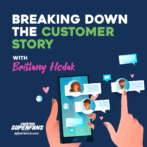Welcome back to the Superfan Series! This video focuses on the various ways you can boost your reputation, referrals, and revenue by targeting your customer experience. Throughout this 5-part system, we explore what it means to be SUPER, and we’ll teach you how to transform your brand into one built on story, connection, and value.
In this video, we examine the first part of the S.U.P.E.R. system: telling your story. Learning how to tell your story might sound intimidating, but it all comes down to one key question. What makes you the absolute best person in your market? Continue through this guide to learn about what it means to tell your story from our superfan expert, Brittany Hodak.
How to Start with Your Story
First, what does it mean to start with your story? This might seem like you should always lead with your story by using it at the start of each customer conversation, but that isn’t the case. Instead, start by defining your superpower. What is it that you do better than anyone else in your market?
Perhaps you’re the best at selling cars, homes, or connecting people with the right insurance policy. When you identify your superpower, you go from a commodity provider to a category of one—a leading expert in your field. This helps to make you the easy choice compared to competitors.
Starting with your story leverages your unique experience to connect with prospective customers. Because you’ve positioned yourself through your story as an expert, you land more referrals and boost your inbound lead potential.
Why Do Stories Sell?
Why are stories so important in the first place? As humans, storytelling is in our DNA. It’s how people have connected, passed down information since the earliest days of civilization.
We actually see the world through stories. People reportedly retain over 65% of information shared through stories, whereas they only retain 5-10% of information through statistics or a dry presentation of facts. If you want to make an impact on your audience, you need a powerful story.
When we make purchase decisions, we base these actions on our emotions. By including your story in all aspects of your brand, you create something that appeals to both logic and feeling. In your story, you’re the superhero and you’re the main focus. This drives real-world action for customers.
How to Find Your Story
Now that you recognize the importance of storytelling, how do you understand what story you have to tell? Start with your origin story, and ask yourself these questions:
- What made you into what you are today?
- Who are the main characters in your story (founders, mentors, etc.)?
- What obstacles did you overcome?
Once you understand your uniqueness and your origin story, you’re ready to tell customers why you’re the best fit for them. This is the perfect litmus test for all of your customer communications (social media, website copy, email sequences). Your messaging should tell the same story, creating real connections with each interaction.
When you’re creating your origin story, it’s tempting to make it as general as possible. A general story is relatable to more people, right? However, this isn’t necessarily the case. In reality, people connect to real, raw emotion and details. When you’re specific and detailed, people truly understand your perspective in a meaningful way. This is your story setlist, and you become your very own superhero in your quest for superfans.
What Story Will You Tell?
In conclusion, your story is one of your biggest assets as a brand. When it comes to standing out and becoming a real-world expert, use your story to its fullest potential. This is the first step in the S.U.P.E.R. system, and without it, you don’t have the right foundation to connect with potential superfans.
Download the Superfan Playbook to create your unique origin story and story setlist. The Playbook helps you uncover what’s important so you can share your story when it matters most. From there, join Brittany in the next segment where she explains how to understand your customer story, and learn how superfans are created at the intersection between your story and theirs.











